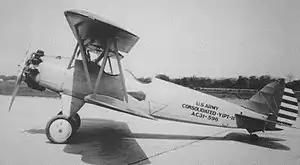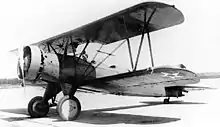Consolidated PT-11
The Consolidated Model 21 was an American two-seat training aircraft built by the Consolidated Aircraft Company. It was used by the United States Army Air Corps with the designation PT-11 and the United States Coast Guard under the designation N4Y.
| PT-11 | |
|---|---|
 | |
| Consolidated Y1PT-11 | |
| Role | Primary trainer |
| Manufacturer | Consolidated Aircraft Company, Fleet Aircraft |
| Introduction | 1931 |
| Primary users | United States Army Air Corps United States Coast Guard |
| Number built | 41[1][2] |
Design and development
The Model 21 was an aerodynamic cleaned up version of the Model 12/PT-3, one of the distinguishing features being curved instead of angular tail surfaces. The aircraft was a single-engined biplane with fixed tailwheel landing gear and accommodation for two in open cockpits.
Operational history
Designated the PT-11 by the United States Army Air Corps it progressed through a number of trial variants but was not built in large numbers. 11 Examples of the model 21-C were built in Canada as the 21-M for Mexico but none were built for local use.
Variants
- XPT-933
- (Model 21A). Prototype powered by 170 hp (130 kW) Kinner engine, first flew February 1931.[3]
- YPT-11
- Evaluation aircraft for US Army based on the Model 21A with a 165 hp (123 kW) Continental R-545-1 engine, four built.[3]
- PT-11A
- One YPT-11 was re-engined with a 175 hp (130 kW) Curtiss R-600-1 Challenger engine, originally as Y1PT-11A, later converted to PT-11C standard.[3]
- Y1PT-11B
- One YPT-11 was re-engined with a 210 hp (160 kW) Kinner YR-720-1 engine and designated Y1PT-11B. 5 production aircraft for US Army with another for the United States Coast Guard and designated N4Y-1.[4]
- PT-11C
- PT-11A re-engined with a 180 hp (130 kW) Lycoming YR-680-1 engine. One or two converted for US Army, with 18 new-build aircraft for Colombia.[5]
- PT-11D
- Production version with 220 hp (160 kW) R-680-3 engine, originally designated Y1PT-11D. 21 new-built, plus five conversions from Y1PT11-Bs and two from Y1PT-11s.[5]
- PT-12
- A version of the PT-11 with a 300hp R-985-1 engine and detailed changes, ten built later redesignated BT-7.

- Y1BT-6
- One YPT-11 was re-engined with a 300hp R-985-1
- BT-6
- Redesignation of Y1BT-6.

- BT-7
- PT-12 aircraft redesignated.
- XN4Y-1
- Evaluation aircraft for the United States Coast Guard, three built.
- N4Y-1
- One YPT-11B for the USCG, later modified to the same standard as the XN4Y-1
Operators
- Colombian Air Force (PT-11C).
- Paraguayan Air Arm (Model 21-C).
- Mexican Air Force (Model 21-M).
Specifications (PT-11D)
Data from "The Illustrated Encyclopedia of Aircraft (Part Work 1982-1985)" Orbis Publishing
General characteristics
- Crew: two
- Length: 26 ft 11 in (8.20 m)
- Wingspan: 31 ft 7 in (9.63 m)
- Height: 9 ft 8 in (2.95 m)
- Wing area: 280 sq ft (26.01 m2)
- Empty weight: 1,918 lb (870 kg)
- Max takeoff weight: 2,585 lb (1,173 kg)
- Powerplant: 1 × Lycoming R-680A radial piston, 200 hp (149 kW)
Performance
- Maximum speed: 118 mph (190 km/h, 103 kn)
- Service ceiling: 13,700 ft (4,175 m)
See also
References
- "U.S. Army Aircraft 1908-1946" by James C. Fahey, 1946, 64pp.
- "Fleet".
- Wegg 1990, p. 64.
- Wegg 1990, p. 65.
- Wegg 1990, pp. 64–65.
- The Illustrated Encyclopedia of Aircraft (Part Work 1982-1985). Orbis Publishing.
- Wegg, John (1990). General Dynamics Aircraft and their Predecessors. London: Putnam Aeronautical Books. ISBN 0-85177-833-X.